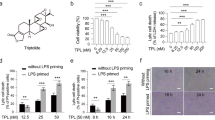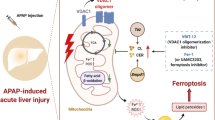Abstract
The inflammatory response plays an important role in carbon tetrachloride (CCl4)-induced acute liver injury and methane has been shown to exert beneficial effects on inflammation-associated diseases. Thus, we investigated the potential protective effects of methane-rich saline (MS) on CCl4-induced acute liver injury and explored the underlying mechanism. A CCl4-induced acute liver injury model was established by injection of CCl4 (0.6 ml/kg, ip) in mice followed by treatment with MS (16 ml/kg, ip), 24 h later. All groups of mice were sacrificed and blood and liver tissues were collected. Serum aminotransferase, necrotic areas, and inflammatory cell infiltration in liver slices were enhanced after CCl4 treatment but decreased with MS treatment. IL-6, TNF-α, IL-1β, IFN-γ, ICAM-1, CXCL1, MPO, NF-κB p65, ERK, JNK, and MAPK P38, expression in serum or liver homogenate were greater after CCl4 treatment but comparatively less after MS treatment. Only IL-10 increased after MS treatment. Anti-IL10 blockade (1.5 mg/kg) restored MS-mediated attenuated phosphorylation of NF-ĸbB/MAPK and the protective effect of MS was abolished for all indices examined. The PI3K inhibitor, wortmannin had the same effects on MS as anti-IL-10 antibody. MS also induced phosphorylation of GSK-3β and AKT in CCl4-treated mice. After pre-treatment with wortmannin (0.7 mg/kg), phosphorylation of GSK-3β and AKT proteins were reduced compared to its solvent control group-DMSO-treated animals. Thus, the data provide evidence that MS may activate the PI3K–AKT–GSK-3β pathway to induce IL-10 expression and produce anti-inflammatory effects via the NF-κB and MAPK pathways. The findings provide a new pharmacological strategy for management of inflammatory response after acute liver injury.




Similar content being viewed by others
References
Abdel-Moneim AM, Al-Kahtani MA, El-Kersh MA et al (2015) Free radical-scavenging, anti-inflammatory/anti-fibrotic and hepatoprotective actions of taurine and silymarin against CCl4 induced rat liver damage. PLoS ONE 10:e0144509
Ananieva O et al (2008) The kinases MSK1 and MSK2 act as negative regulators of Toll-like receptor signaling. Nat Immunol 9:1028–1036
Bekker Z, Walubo A, Du Plessis JB et al (2016) Changes in IL-2 and IL-10 during Chronic Administration of Isoniazid, Nevirapine, and Paracetamol in Rats. Adv Pharmacol Sci 11:3094783
Beurel E, Michalek SM, Jope RS et al (2010) Innate and adaptive immune responses regulated by glycogen synthase kinase-3 (GSK3). Trends Immunol 31:24–31
Beurel E, Grieco SF, Jope RS et al (2015) Glycogen synthase kinase-3 (GSK3): regulation, actions, and diseases. Pharmacol Ther 148:114–131
Boros M, Ghyczy M, Érces D et al (2012) The anti-inflammatory effects of methane. Crit Care Med 4:1269–1278
Cao S, Zhang X, Edwards JP, Mosser DM (2006) NF-kappaB1 (p50) homodimers differentially regulate pro- and anti-inflammatory cytokines in macrophages. J Biol Chem 281:26041–26050
Chen O, Ye Z, Cao Z et al (2015) Methane attenuates myocardial ischemia injury in rats through anti-oxidative, anti-apoptoticand anti-inflammatory actions, Free Radic Biol Med 90:1–11
Douglas DB, Beiting DP, Loftus JP et al (2010) Combinatorial effects of interleukin 10 and interleukin 4 determine the progression of hepatic inflammation following murine enteric parasitic infection. Hepatology 51:2162–2171
Erhardt A, Biburger M, Papadopoulos T et al (2007) IL-10, regulatory T cells, and Kupffer cells mediate tolerance in concanavalin A-induced liver injury in mice. Hepatology 45:475–485
Fan DF, Hu HJ, Sun Q et al (2016) Neuroprotective effects of exogenous methane in a rat model of acute carbon monoxide poisoning. Brain Res 1633:62–72
Gabrysova L, Howes A, Saraiva M et al (2014) The regulation of IL-10 expression. Curr Top Microbiol Immunol 380:157–190
Ghoshal U, Shukla R, Srivastava D et al (2016) Irritable bowel syndrome, particularly the constipation-predominant form, involves an increase in methanobrevibacter smithii, which is associated with higher methane production. Gut Liver 6:932–938
Ghyczy M et al (2008) Hypoxia-induced generation of methane in mitochondria and eukaryotic cells: an alternative approach to methanogenesis. Cell Physiol Biochem 21:251–258
He R, Wang L, Zhu J et al (2016) Methane-rich saline protects against concanavalin A-induced autoimmune hepatitis in mice through anti-inflammatory and anti-oxidative pathways. Biochem Biophys Res Commun 1:22–28
Hovsepian E, Siffo S, Mirkin GA et al (2013) IL-10 inhibits the NF-ĸB and ERK/MAPK-mediated production of pro-inflammatory mediators by up-regulation of SOCS-3 in Trypanosoma cruzi-infected cardiomyocytes. PLoS ONE 8:e79445
Juhaszova M, Zorov DB, Kim SH et al (2004) Glycogen synthase kinase-3beta mediates convergence of protection signaling to inhibit the mitochondrial permeability transition pore. J Clin Invest 113:1535–1549
Kai T, Jones KA, Warner DO et al (1998) Halothane attenuates calcium sensitization in airway smooth muscle by inhibiting G-proteins. Anesthesiology 89:1543–1552
Liu L, Sun Q, Wang R et al (2016) Methane attenuates retinal ischemia/reperfusioninjury via anti-oxidative and anti-apoptotic pathways. Brain Res 1646:327–333
Mackenzie KF, Clark K, Naqvi S, Mcguire VA et al (2013) PGE(2) induces macrophage IL-10 production and a regulatory-like phenotype via a protein kinase A-SIK-CRTC3 pathway. J Immunol 190:565–577
MacKenzie KF et al (2013) PGE(2) induces macrophage IL-10 production and a regulatory-like phenotype via a protein kinase A-SIK-CRTC3 pathway. J Immunol 190:565–577
Maes M, Vinken M, Jaeschke H et al (2016) Experimental models of hepatotoxicity related to acute liver failure. Toxicol Appl Pharmacol 290:86–97
Magaye R, Gu Y, Wang Y et al (2016) In vitro and in vivo evaluation of the toxicities induced by metallic nickel nano and fine particles. J Mol Histol 47:273–286
Martin M, Rehani K, Jope RS et al (2005) Toll-like receptor-mediated cytokine production is differentially regulated by glycogen synthase kinase 3. Nat Immunol 6:777–784
Martin M, Mory C, Prescher A et al (2010) Protective effects of early CD4(+) T cell reduction in hepatic ischemia/reperfusion injury. J Gastrointest Surg 14:511–519
Mittal SK, Roche PA (2015) Suppression of antigen presentation by IL-10. Curr Opin Immunol 34:22–27
Mizuoka H, Shikata N, Yang J et al (1999) Biphasic effect of colchicine on acute liver injury induced by carbon tetrachloride or by dimethylnitrosamine in mice. J Hepatol 31:825–833
Montano-Loza AJ, Bhanji RA, Wasilenko S et al (2017) Systematic review: recurrent autoimmune liver diseases after liver transplantation. Aliment Pharmacol Ther 45:485–500
Nandan D et al (2012) Myeloid cell IL-10 production in response to leishmania involves inactivation of glycogen synthase kinase-3beta downstream of phosphatidylinositol-3 kinase. J Immunol 188:367–378
Ouyang W, Rutz S, Crellin NK et al (2011) Regulation and functions of the IL-10 family of cytokines in inflammation and disease. Annu Rev Immunol 29:71–109
Özdemir-Kumral ZN, Özbeyli D, Özdemir AF et al (2016) Protective effect of nicotine on sepsis-induced oxidative multiorgan damage: role of neutrophils. Nicotine Tob Res 2017(7):859–864
Peng XD, Dai LL, Huang CQ et al (2009) Relationship between anti-fibrotic effect of Panax notoginsengsaponins and serum cytokines in rat hepatic fibrosis. BiochemBiophys Res Commun 388:31–34
Pimentel M et al (2006) Methane, a gas produced by enteric bacteria, slows intestinal transit and augments small intestinal contractile activity. Am J Physiol Gastrointest Liver Physiol 290:G1089–G1095
Puig MM, Warner W, Tang CK, Lovitz M, Turndorf H et al (1988) Synergistic interaction of morphine and halothane in the guinea pig ileum. Anesthesiology 68:559–562
Ren F, Duan Z, Cheng Q et al (2011) Inhibition of glycogen synthase kinase 3 beta ameliorates liver ischemia reperfusion injury by way of an interleukin-10-mediated immune regulatory mechanism. Hepatology 54:687–696
Roccarina D, Lauritano EC, Gabrielli M et al (2010) The role of methane in intestinal diseases. Am J Gastroenterol 105:1250–1256
Rood JE, Canna SW, Weaver LK et al (2016) IL-10 distinguishes a unique population of activated, effector-like CD8+ T cells in murine acute liverinflammation. J Leukoc Biol 2017(4):1037–1044
Sanin DE, Prendergast CT, Mountford AP et al (2015) IL-10 production in macrophages is regulated by a TLR-driven CREB-mediated mechanism that is linked to genes involved in cell metabolism. J Immunol 195:1218–1232
Schwabe RF, Brenner DA et al (2002) Role of glycogen synthase kinase-3 in TNF-alpha-induced NF-kappaB activation and apoptosis in hepatocytes. Am J Physiol Gastrointest Liver Physiol 283:G204–G211
Shao X, Qian Y, Xu C et al (2013) The protective effect of intrasplenic transplantation of Ad-IL-18BP/IL-4 gene-modified fetal hepatocytes on ConA-induced hepatitis in mice. PLoS ONE 8:e58836
Si ZZ, Li JQ, Qi HZ et al (2010) Recombinant adenovirus vector AdhIL-10 protects grafts from cold ischemia-reperfusion injury following orthotopic liver transplantation in rats. Hepatobiliary Pancreat Dis Int 9:144–148
Sokoll MD, Davies LR, Bhattacharyya B, Zwagerman DQ et al (1989) Halothane and isoflurane alter acetylcholine activated ion channel kinetics. Eur J Pharmacol 173:27–34
Song K, Zhang M, Hu J et al (2015) Methane-rich saline attenuates ischemia/reperfusion injury of abdominal skin flaps in rats via regulating apoptosis level. BMC Surg 15:92
Strifler G, Tuboly E, Szél E et al (2016) Inhaled methane limits the mitochondrial electron transport chain dysfunction during experimental liver ischemia-reperfusion injury. PLoS ONE 1:e0146363
Szabo G, Petrasek J (2015) Inflammasome activation and function in liver disease. Nat Rev Gastroenterol Hepatol 7:387–400
Varga G, Erces D, Tuboly E et al (2012) Characterization of the anti-inflammatory properties of methane inhalation during ischaemia-reperfusion. Magy Seb 4:205–211
Venardos KM, Perkins A, Headrick J, Kaye DM et al (2007) Myocardial ischemia-reperfusion injury, antioxidant enzyme systems, and selenium: a review. Curr Med Chem 14:1539–1549
Viatour P et al (2004) GSK3-mediated BCL-3 phosphorylation modulates its degradation and its oncogenicity. Mol Cell 16:35–45
Wang L, Yao Y, He R et al (2016) Methane ameliorates spinal cord ischemia-reperfusion injury in rats: antioxidant, anti-inflammatory and anti-apoptotic activity mediated by Nrf2 activation. Free Radic Biol Med 103:69–86
Wu J, Wang R, Ye Z et al (2015) Protective effects of methane-rich saline on diabetic retinopathy via anti-inflammation in a streptozotocin-induced diabetic rat model. Biochem Biophys Res Commun 2:155–161
Yao Y, Simard AR, Shi FD et al (2013a) IL-10-producing lymphocytes in inflammatory disease. Int Rev Immunol 32:324–336
Yao Y, Simard AR, Shi F (2013b) D.et al, IL-10-producing lymphocytes in inflammatory disease. Int Rev Immunol 32:324–336
Ye Z, Chen O, Zhang R et al (2015) Methane attenuates hepatic ischemia/reperfusion injury in rats through antiapoptotic, anti-inflammatory, and antioxidative actions. Shock 44:181–187
Zhang X, Li N, Shao H et al (2016) Methane limit LPS-induced NF-ĸB/MAPKs signal in macrophages and suppress immune response in mice by enhancing PI3K/AKT/GSK-3β-mediated IL-10 expression. Sci Rep 6:29359
Zhao X, Shi X, Zhang Z et al (2016) Combined treatment with MSC transplantation and neutrophil depletion ameliorates D-GalN/LPS -induced acute liver failure in rats. Clin Res Hepatol Gastroenterol 6:730–738
Acknowledgements
This work was supported by National Natural Science Foundation (81471845, 81671939) and Shanghai Scientific research project (15411963200).
Author information
Authors and Affiliations
Corresponding authors
Ethics declarations
Conflicts of interest
All authors have no potential financial or ethical conflicts of interest regarding this paper.
Additional information
Ying Yao, Liping Wang and Peipei Jin have contributed equally to this work.
Electronic supplementary material
Below is the link to the electronic supplementary material.
Rights and permissions
About this article
Cite this article
Yao, Y., Wang, L., Jin, P. et al. Methane alleviates carbon tetrachloride induced liver injury in mice: anti-inflammatory action demonstrated by increased PI3K/Akt/GSK-3β-mediated IL-10 expression. J Mol Hist 48, 301–310 (2017). https://doi.org/10.1007/s10735-017-9728-1
Received:
Accepted:
Published:
Issue Date:
DOI: https://doi.org/10.1007/s10735-017-9728-1




